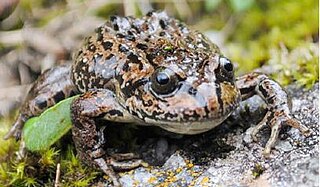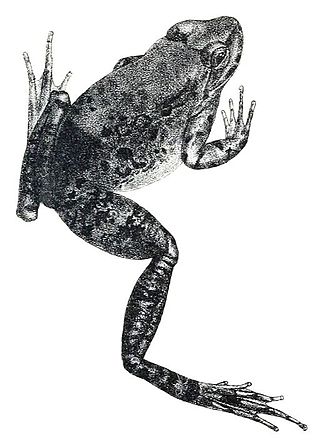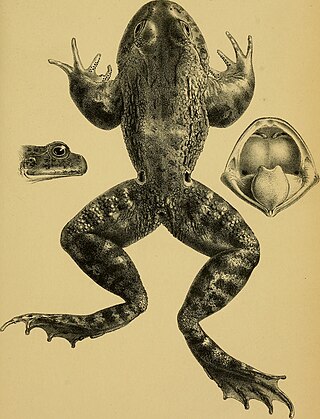The rough-skinned horned toad or Tonkin spadefoot toad is a species of frog in the family Megophryidae. It is found in southern China, northern Vietnam, and northern Laos.
Amolops loloensis is a species of frog in the family Ranidae that is found in southern and western Sichuan and one locality in north-central Yunnan, China. Its natural habitats are small mountain streams in forests and grasslands. It is threatened by infrastructure development for human settlement, potentially also by water pollution from the mining industry. T

The Doichang frog is a species of frog in the family Dicroglossidae. It is only known from its type locality, Doi Chang, mountain north of Chiang Mai (Thailand), Fansipan mountain in northern Vietnam, and Huanglianshan National Nature Reserve in Yunnan, China.
Nanorana quadranus is a species of frog in the family Dicroglossidae. It is endemic to central China. Its natural habitats are temperate forest and shrubland, with breeding taking place in small rivers. It is a common species believed to be declining. It is threatened by collection for food and also habitat loss.
Nanorana unculuanus is a species of frog in the family Dicroglossidae. It is endemic to central and southern Yunnan, China, although it is expected to have wider distribution than currently known, possibly extending into Vietnam. Its natural habitats are fast-flowing hill streams and riparian habitats in forests and grasslands, but also man-made habitats like roadside drainage ditches and ponds. It is a rare and secretive species that appears to be declining. It is currently threatened by collection for food and also by habitat loss.

Nanorana pleskei is a species of frog in the family Dicroglossidae. Until recently it has been only known from southwestern/central western China from elevations between 3,300–4,500 m (10,800–14,800 ft), but there is now one record also from Bhutan. Notice, however, that earlier records outside China have turned out to be misidentifications.
Nanorana ventripunctata is a species of frog in the family Dicroglossidae. It is endemic to northwestern Yunnan, China. It inhabits lakes, pools and ponds in alpine areas, occurring near streams and rivers in open, high-elevation habitats. It breeds in still-water pools and ponds.
Nanorana arnoldi is a large species of frog in the family Dicroglossidae. It is found in southwestern China, northern Myanmar, eastern Nepal, and adjacent northeastern India. Its natural habitats are subtropical or tropical moist montane forest, rivers, and freshwater springs. It is primarily threatened by collection for consumption, but also by habitat loss.

Nanorana blanfordii is a species of frog in the family Dicroglossidae. It is found in northeastern India, southern Tibet (China), and eastern Nepal, and likely in the adjacent western Bhutan. The specific name blanfordii honours William Thomas Blandford, a British geologist and zoologist.

Nanorana conaensis is a species of frog in the family Dicroglossidae. Its name refers to its type locality, Mama in Cona County in Tibet. Note that while large parts of Cona County are located within Arunachal Pradesh in the area that is controlled by India but claimed by China, Mama is on the Tibetan side of the border. It has recently been reported also from Bhutan. Its natural habitats are subtropical moist montane forest, high-altitude shrubland, and rivers.
Nanorana ercepeae is a species of frog in the family Dicroglossidae. It is endemic to western Nepal. This relatively rare frog is found in stream habitats in upland temperate rainforests. It is threatened by habitat loss and degradation caused by small-scale agricultural development and wood extraction.

Nanorana feae is a species of frog in the family Dicroglossidae. It is found in Yunnan, China, and the Kachin Hills in Myanmar. The specific name feae honors Leonardo Fea, an Italian explorer, zoologist, and naturalist. This little-known species probably inhabits hill streams in forested areas.

Nanorana liebigii, also known as Sikkim paa frog, Liebig's paa frog, Liebig's frog, and spiny-armed frog, is a species of frog in the family Dicroglossidae. It is found in the Himalayas, specifically in Bhutan, southern Tibet (China), northern India, and Nepal. The specific name liebigii honours a certain "Dr von Liebig Jr.", likely referring to Justus von Liebig, German botanist and chemist.
Nanorana maculosa is a species of frog in the family Dicroglossidae. It is endemic to central Yunnan, China, where it occurs in Jingdong County and Shuangbai County. This rare frog inhabits forest streams. It is threatened primarily by collection for human consumption. It is currently protected by the Ailaoshan and Wuliangshan National Nature Reserves.
Nanorana medogensis is a species of frog in the family Dicroglossidae. It is endemic to Tibet, China, and only known from near its type locality in Mêdog County in southeastern Tibet, near the Indian border. It lives in forested streams, and is sometimes also found at the edges of pools and ponds.
Nanorana polunini is a species of frog in the family Dicroglossidae. It is found in Nyalam County in southern Tibet (China), Nepal, and possibly Kashmir (India). It is a common species in Nepal but rare in China. It lives in stream habitats in montane forest.
Nanorana rarica is a frog species in the family Dicroglossidae. It is endemic to western Nepal. Its type locality is the eponymous Rara Lake located in the Rara National Park.

Quasipaa spinosa is a species of frog in the family Dicroglossidae. It is known under many common names, including Chinese spiny frog, giant spiny frog, Chinese edible frog, and spiny paa frog. Its names refer to the distinctive characteristics of the species, relatively large size and the spiny chest of male frogs. Giant in frog terms only, it can nevertheless grow to lengths above 10 cm (4 in); this makes it the largest frog in Hong Kong.
Odorrana andersonii is a species of frog in the family Ranidae that is found in northeastern India, Upper Myanmar, southwestern China, northern Thailand, Laos, and Vietnam; records from Laos and Vietnam may refer to another species. They are found in low tree branches and on rocks along shaded rocky streams and large rivers with boulders, in evergreen forests and agricultural areas. Breeds takes place in streams.
Gracixalus gracilipes, commonly known as the Chapa bubble-nest frog, black eye-lidded small tree frog, yellow and black-spotted tree frog or slender-legged bush frog, is a species of shrub frog from northern Vietnam, southern China, and northwestern Thailand.







